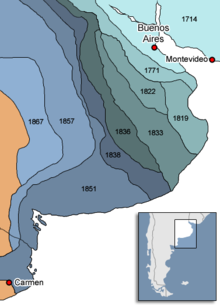Conquest of the Desert
Mapuche tribes The Conquest of the Desert (Spanish: Conquista del desierto) was an Argentine military campaign directed mainly by General Julio Argentino Roca during the 1870s and 1880s with the intention of establishing dominance over Patagonia, inhabited primarily by indigenous peoples.
As more settlers developed properties, the frontier dividing the colonial farms and the Indian territories gradually moved outwards from Buenos Aires.
Due to land loss and environmental devastation caused by cattle, many natives were forced to abandon their tribes to work on the farms.
Historian George V. Rauch notes evidence that Chilean authorities knew about the origin of the cattle and consented to the trading in order to strengthen their influence over Patagonian territories.
[5] In 1875, Adolfo Alsina, Minister of War for President Nicolás Avellaneda, presented the government with a plan which he later described as having the goal "to populate the desert, and not to destroy the natives.
Our self-respect as a virile people obliges us to put down as soon as possible, by reason or by force, this handful of savages who destroy our wealth and prevent us from definitely occupying, in the name of law, progress and our own security, the richest and most fertile lands of the Republic.At the end of 1878 he started the first sweep to "clean" the area between the Alsina trench and the Rio Negro by continuous and systematic attacks on the Indian settlements.
On 6 December 1878, elements of the Puán Division commanded by Colonel Teodoro García clashed with a native war party at the Lihué Calel heights.
[9] Numerous armed encounters would follow, until by December 1878, more than 4,000 natives had been captured and 400 killed, 150 settlers freed, and 15,000 head of cattle recovered.
[11] It was in this context that German Chilean Carlos Wiederhold established the trading post and shop La Alemana in 1895, from which the city of Bariloche developed.
[12] On 16 January 1883, a 10-man section of a platoon of the Argentine Army in pursuit of a large Indian war party, ran into an ambush in the Pulmarí Valley set by Chilean soldiers.
[citation needed] Literary scholar Jens Andermann has noted that contemporary sources on the campaign conclude that the Conquest was intended by the Argentine government to exterminate the indigenous tribes, and can be classified as genocide.
"[3][4] The Argentine Republic in Patagonia "for the colonisation of the bottom of the country, a raid was made against these poor harmless children of nature, and many tribes were wiped out of existence.
[16] Apologists perceive the campaign as intending to conquer specifically those Indigenous groups who refused to submit to Argentine law and frequently performed brutal attacks on frontier civilian settlements.
[17] In these attacks, the Natives stole many horses and cattle, killed settlers defending their livestock, and captured women and children to become slaves and/or forced brides of Indian warriors.
[18][19] The Guardian alleged in 2011 that two education officials lost their jobs due to the controversy concerning the Conquest of the Desert: It reported that Juan José Cresto was forced to resign as a director of the Argentine National Historical Museum because he said the indigenous people "were violent parasites who attacked farms and kidnapped women"[4] and Beatriz Horn, a history teacher in La Pampa Province, was dismissed for "telling a radio station that Roca deserved praise for putting natives to flight and opening Argentina's frontier to European settlers".
[4] Argentine news sources, however, report Juan José Cresto lost his job for being abusive and violent towards employees[20] and Beatriz Horn was dismissed due primarily to her praise for the military dictator Leopoldo Galtieri.
A statue of Roca in the civic center of Bariloche is a frequent site for protests and graffiti by local Amerindian activist organizations.



